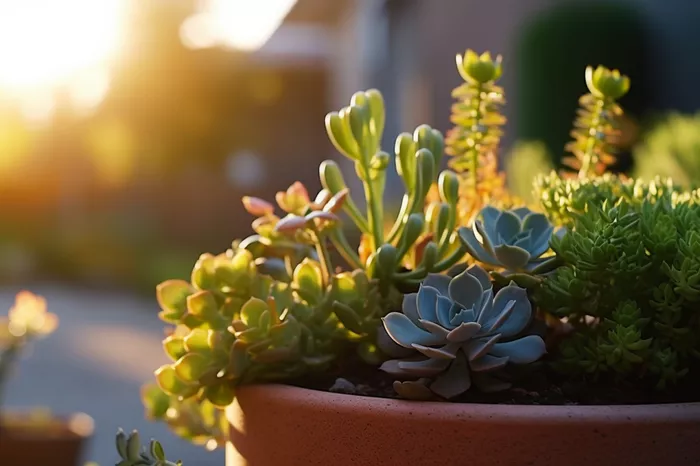Succulents, with their captivating forms and vibrant colors, have surged in popularity among plant enthusiasts. These resilient plants are renowned for their ability to thrive in diverse conditions while adding a touch of greenery to any space. However, as succulents grow, they may sometimes become leggy or too tall, detracting from their aesthetic appeal. If you find yourself facing this dilemma, fear not! There are several strategies you can employ to address the issue and restore your succulent to its former glory.
Understanding Succulent Growth
Before delving into solutions, it’s essential to understand why succulents become tall and leggy. Succulents typically grow tall and stretch out when they don’t receive adequate sunlight. In their natural habitat, succulents thrive in sunny, arid environments with plenty of direct sunlight. Insufficient light indoors or in shaded areas can cause succulents to elongate as they reach for light, resulting in a stretched appearance.
Additionally, overcrowded conditions can contribute to succulents growing tall and leggy. When multiple succulents are planted closely together, they compete for light and space, leading to vertical growth as they strive to access more sunlight.
Assessing Your Succulent’s Needs
Before taking corrective action, assess your succulent’s current environment and condition. Determine whether insufficient light or overcrowding is causing its tall, leggy growth. Observing the following factors can help you identify the root cause:
1. Light Conditions: Evaluate the amount and intensity of light your succulent receives daily. Succulents generally require at least six hours of bright, indirect sunlight each day to thrive. Insufficient light can cause stretching and elongation as the plant attempts to reach for sunlight.
2. Spacing: If your succulent is planted in a container with other plants or is crowded in its current location, it may be competing for resources and stretching out to access more light and space.
3. Soil Drainage: Check the soil drainage to ensure it’s well-draining and not waterlogged. Poor drainage can lead to root rot, which may manifest as leggy growth and other signs of distress in succulents.
Strategies to Correct Tall and Leggy Succulents
Once you’ve identified the factors contributing to your succulent’s tall growth, you can implement appropriate measures to address the issue effectively. Consider the following strategies:
1. Provide Adequate Sunlight
Position your succulent in a location where it receives ample sunlight throughout the day. Ideally, place it near a south-facing window where it can benefit from direct sunlight for several hours daily. If natural light is limited, supplement with grow lights designed for succulents to ensure they receive sufficient light intensity.
Rotate your succulent regularly to promote even growth and prevent it from leaning towards one side due to uneven light exposure. Outdoor succulents should be placed in a sunny spot with well-draining soil to encourage healthy growth.
2. Prune Leggy Growth
If your succulent has already become tall and leggy, pruning can help restore its compact, aesthetic appearance. Use clean, sharp scissors or pruning shears to trim the elongated stems back to the desired length. Focus on removing the stretched-out growth while preserving the healthy foliage at the base of the plant.
Make clean cuts just above a leaf node or joint to encourage new growth and prevent the stems from rotting. Allow the cuts to callus over for a few days before replanting the pruned stems if desired.
3. Propagate Healthy Cuttings
Rather than discarding the pruned stems, consider propagating them to create new succulent plants. Allow the cuttings to callus over for a few days to prevent moisture-related issues, then place them in well-draining soil or a succulent propagation mix.
Ensure the cuttings receive indirect sunlight and mist them lightly to keep the soil slightly moist until roots develop. Over time, the cuttings will establish roots and grow into new succulent plants, allowing you to expand your collection or share them with fellow plant enthusiasts.
4. Replant in a Spacious Container
If overcrowding is contributing to your succulent’s tall growth, consider replanting it in a more spacious container with adequate room for root expansion. Choose a container with drainage holes to prevent waterlogging and use a well-draining succulent potting mix to promote healthy root growth.
When transplanting your succulent, gently loosen the roots and remove any excess soil clinging to them. Position the plant in the center of the new container and fill in the gaps with fresh potting mix, ensuring the soil level remains consistent with the base of the plant.
5. Adjust Watering Practices
Proper watering is crucial for maintaining the health and vitality of succulents. While succulents are drought-tolerant plants, they still require occasional watering to thrive. However, overwatering can lead to root rot and other moisture-related issues, which may contribute to leggy growth.
Establish a watering routine based on the specific needs of your succulent species and environmental conditions. Allow the soil to dry out completely between waterings, and avoid watering on a fixed schedule. Instead, monitor the moisture levels of the soil and adjust your watering frequency accordingly.
Conclusion
Tall and leggy succulents can detract from their natural beauty and aesthetic appeal. However, with proper care and attention, you can address the underlying factors contributing to their elongated growth and restore them to a compact, healthy state.
By providing adequate sunlight, pruning leggy growth, propagating healthy cuttings, replanting in spacious containers, and adjusting watering practices, you can help your succulents thrive and flourish in their environment. With patience and perseverance, you’ll be rewarded with lush, vibrant succulent plants that bring joy and tranquility to any space they inhabit.


